I had an uneventful journey from Wolverhampton using the London Midland service to Liverpool South Parkway where I changed to a Merseyrail train for the short journey to Brunswick. It had been cold and overcast when I started from home but at Brunwick, there was bright sun and the day remained very pleasant, except for a brief shower in the early afternoon. On my first visit, I'd been able to walk directly from the station to the river by crossing through the Brunswick Business Park but, on Saturday, I was rather surprised to find the Harrison Way gates securely locked. A small sign, which I almost failed to spot, directed me south along Sefton street to reach the Riverside Walk.
This led me past a series of modern, smaller business premises on the left (many car-related) and huge modern warehouses on to my right, the second of which was occupied by TeamSport Go Karting (see their site here).
My detour offered me a view of the unusual entrance to the C.L.C. Dingle tunnel, now used by Merseyrail services to Hunts Cross. The tunnel is approached by a short, deep rock cutting carrying an iron bridge which provides support for the area around Grafton Street.
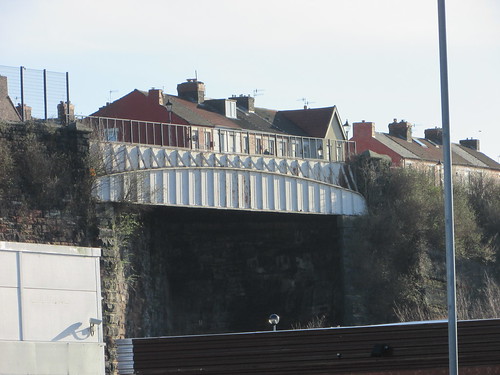
The unusual north portal to Dingle Tunnel on the C.L.C. (now Merseyrail), with the houses on Grafton Street in the background.
Just beyond this tunnel, there is the partially bricked-up entrance to the abandoned Liverpool Overhead tunnel. The sandstone portal remained in excellent condition, with the inscriptions clearly legible - 'L. O. Ry. SOUTHERN EXTENSION | 1896 | ENGINEERS SIR DOUGLAS FOX, J.H. GREATHEAD, S. B. COTTRELL | CHAIRMAN SIR WILLIAM BOWER FORWARD | CONTRACTORS H. M. NOWELL, C. BRADDOCK'.
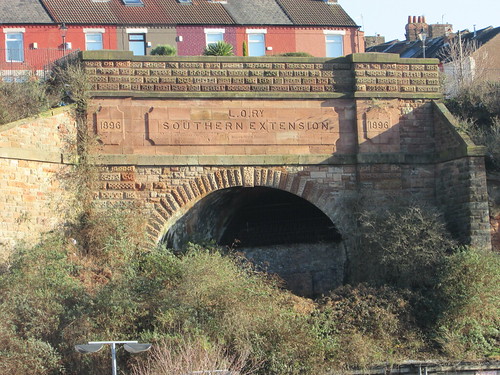
Liverpool area rail: Entrance to abandoned Liverpool Overhead Railway Extension tunnel built 1896.
On my right,I passed the brick-built transit shed which had served the east side of the now-filled-in Harrington Dock. This has been retained and modernised as the South Harrington Building, partly occupied by Royal Mail.
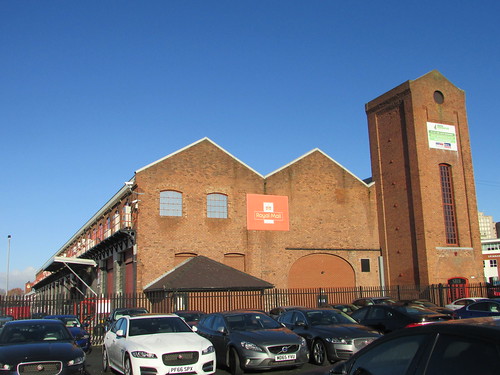
South Harrington Building, showing, on the left, the long elevation which faced the dock.
I turned into the service road and almost missed the small gate giving access to the Riverside Walk next to the filled-in 80-foot wide entrance to Herculaneum Dock. On the other side of the dock entrance I could see Chung Ku Chinese Restaurant. There had been a second 60-foot wide entrance to the south of the restaurant.
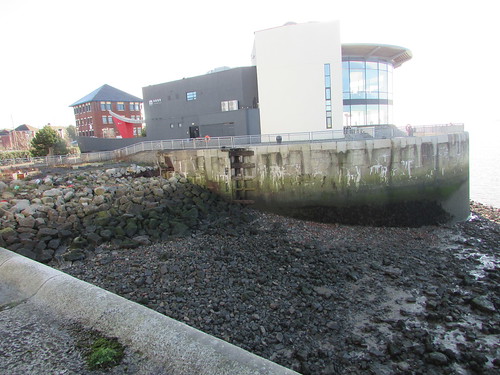
Views around former south docks: Chung Ku Chinese Restaurant and the filled-in entrance to former Herculaneum Dock.
The 1909 plan below shows where I started of my walk, near point 'L' on the plan.
Plan of Toxteth to Herculaneum Docks

Liverpool Docks Admiralty Maps, 1909, Plate 30 (Source: Wikimedia Commons).
Click here for a larger view.
I continued northwards along Riverside Walk, towards Pierhead (heading left on the plan above). There were occasional bicycles, joggers and walkers whose numbers increased as I came nearer to Pierhead. After passing the filled-in Harrington Dock, I had good views of the Tranmere oil handling installations on the Wirral side of the river.
There are two berths for oil tankers. The upstream berth was occupied by the chemical/oil products tanker 'Cenito', owned by LGR di Navigazione Spa and built in China in 2009. The ship's 'vital statistics' are here. The 'SUPER ICE' painted in the hull initially puzzled me - it's because she is classified 'Ice Class 1A Super' which is the highest of the Finnish-Swedish Ice Class ratings, allowing her to operate in difficult ice conditions without icebreaker assistance. Brief research on the internet subsequently showed that her recent ports-of-call included Antwerp and Aruba (in the Caribbean).

'Cenito' berthed at Tranmere.
The other berth at Tranmere was unoccupied (except by a tug), allowing a better view of the loading/unloading facilities.

Loading/unloading berth at Tranmere. The tug 'Switzer Stanlow' (with firefighting equipment) is moored at the berth.
I walked past more modernised transit sheds on my right, flanking the filled-in Toxteth Dock and saw parents with young children going into Yellow Sub, which describes itself as "Liverpool's Premier Play Centre". The only reminder of the lock which once connected Toxteth Dock directly to the river was a capstan, set within modern paving.
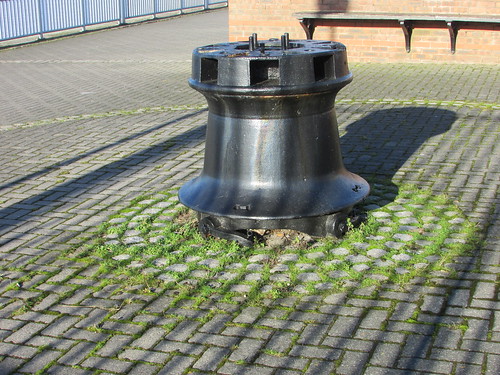
Liverpool - Capstan at former Toxteth Dock.
The 1909 plan below shows the continuation of my walk.
Plan of Queens to Toxteth Docks
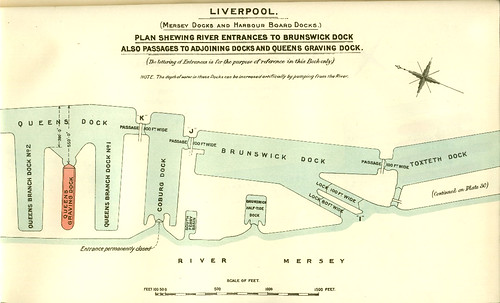
Liverpool Docks Admiralty Maps, 1909, Plate 29 (Source: Wikimedia Commons).
Click here for a larger view.
I then had views of the Cammell Laird shipyard on the Birkenhead side. At a landing stage near the massive shipbuilding hall, two small craft were moored. They were 'Njord Forset' and 'Njord Odin', both 21m multi-purpose crew transfer vessels for the offshore windfarm industry, operated by Njord Offshore Ltd. There is more information on these vessels here.
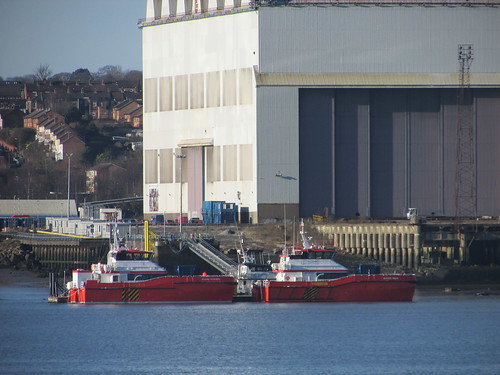
Liverpool: 'Njord Forseti' and 'Njord Odin' moored near the Cammell Laird Shipbuilding Hall.
The locks for Brunswick Dock were the next feature on my walk.
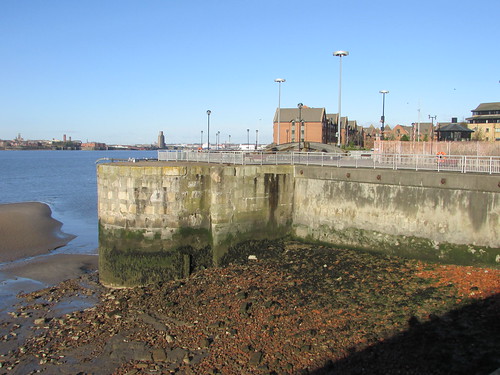
Liverpool: Entrance to Brunswick Dock looking towards housing at Clippers Quay with Birkenhead in the left background.
There were two parallel locks which entered the river diagonally. The larger lock to my right was 100 feet wide but has been filled-in. The second lock, originally 80 feet wide, has been retained and modernised allowing Brunswick Dock and the adjacent Coburg Dock to be used as marinas for pleasure craft.
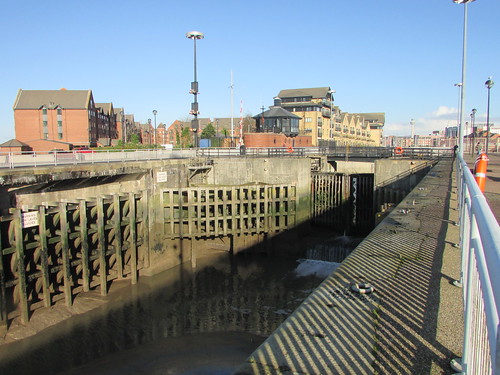
Liverpool: The 80-foot lock chamber at Brunswick Dock, adapted to provide a smaller, working lock for modern pleasure craft.
Whilst most Docks were connected to the river via locks with two sets of lock gates allowing vessels to enter and leave at any state of the tide, the small Brunswick Half-Tide Dock (as hinted by the name) had only one set of wooden lock gates, still in place but not in use.
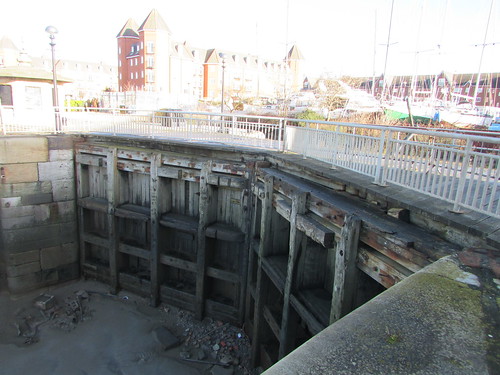
Liverpool: Wooden Lock Gates at Brunswick Half Tide Dock.
The dock itself has been filled and surfaced and now serves as an out-of-the-water storage area for pleasure craft. The remaining walls facing the river, the two Lock-Keeper's Offices and the windlasses to work the gates and sluices give an impression of the meticulous attention to detail of Jesse Hartley, who was the Dock Engineer from 1824 to 1860. There's a little more about this remarkable man in the post Notes on Liverpool and its Docks.
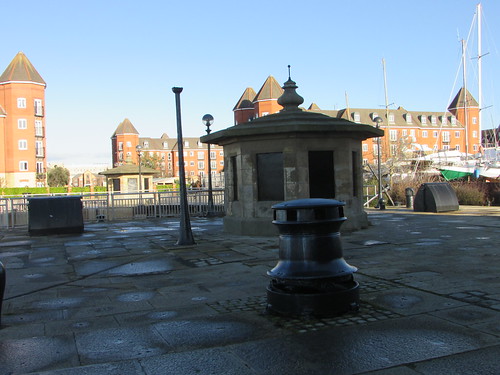
Liverpool: Two Lock-Keeper's Offices at Brunswick Half Tide Dock.
Beyond Brunswick Half Tide Dock, the curved river wall with a set of stone steps gave testimony to the quality and endurance of the works carried out by Jesse Hartley.

Liverpool: Jesse Hartley's stonework near Brunswick Half Tide Dock.
I then came to a small tidal dock - South Ferry Basin. Once the river teemed with ferries linking both sides of the River Mersey, now a single Mersey Ferry operates a triangular route Pierhead - Seacombe - Birkenhead Woodside and the South Ferry Basin is long out of use and silted-up.
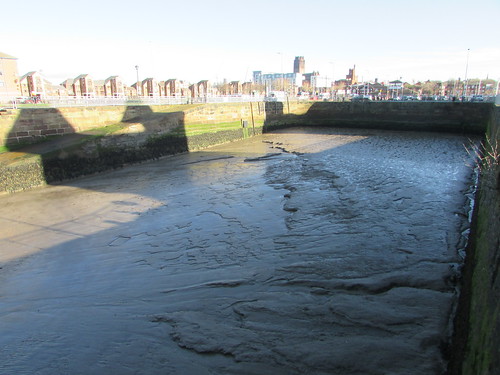
Liverpool: South Ferry Basin.
Coburg Dock came next. Originally, this dock had a single set of gates leading to the river, like Brunswick Half Tide Dock. But the 1909 plan shows this entrance permanently closed because a 100-foot wide passage linked Coburg Dock to Brunswick Dock from where 80-foot wide and 100-foot wide locks offered non-tidal connection to the river. Coburg Dock, still linked to Brunswick Dock, now forms part of Liverpool Marina. A launch area and slipway has been constructed at the river end of the dock.
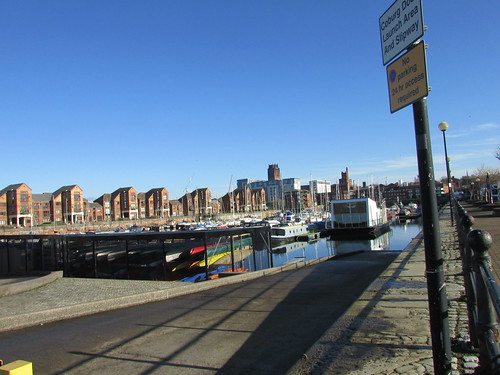
Liverpool: Coburg Dock, showing launch area and slipway.
The footpath was now joined by a road called Kings Parade which has a bus service. I passed the end of Queens Branch Dock No. 1 which has received a new role as the home of Liverpool Watersport Centre (LWC). The Centre is one of the initiatives run by a local charity called Local Solutions, with support from the European Social Fund.

Liverpool: 'wakeboarding' at the Liverpool Watersport Centre in Queens Dock.
Never having heard of 'wakeboarding', I was puzzled by a series of what looked like waterski jumps and two overhead cable systems installed in the end of dock nearest me and. Two young people started performing which clarified the activity. The wakeboard is a short, modified single waterski. The cable system replaces a speedboat. The user attaches to the cable system which drags the performer in one direction before reversing and dragging them back. The user performs a '180 degree' turn at each end of the course and attempts waterski jumps along the course. The System 2.0 Wake Park site here lists 27 'Wake Parks' in the U.K. - the Liverpool Wake Park has a site here and British Water Ski & Wakeboard is the sport's governing body and membership organisation.
The expedition was becoming a little surreal, not helped by the fate of the next dock - Queens Graving Dock. Fashionable apartments called The Keel comprised one block on either side of the flooded dock and two shorter blocks bridge-like across the dock, forming a rectangle. I was now in a thoroughly modern environment passing, in turn, the three modern venues along Kings Parade, Exhibition Centre Liverpool, BT Convention Centre, ECHO Arena. All three are run as an integrated events centre by ACC Liverpool, who have an introductory video with 'drone footage' here. The Exhibition Centre is the most recent addition with a website here. The Pullman Hotel is integrated into this building.
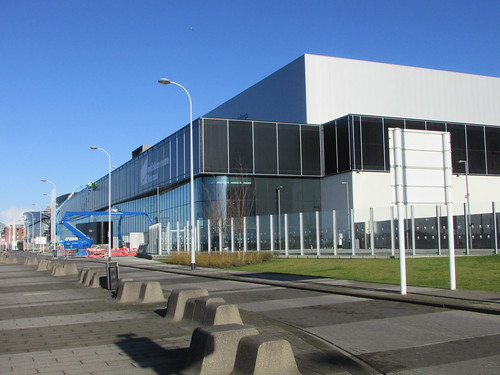
Exhibition Centre Liverpool, Kings Parade.
Then I hurried past the Convention Centre and ECHO Arena towards the Albert Dock and the Waterfront area, concluding my first exploration to Liverpool's former South Docks.
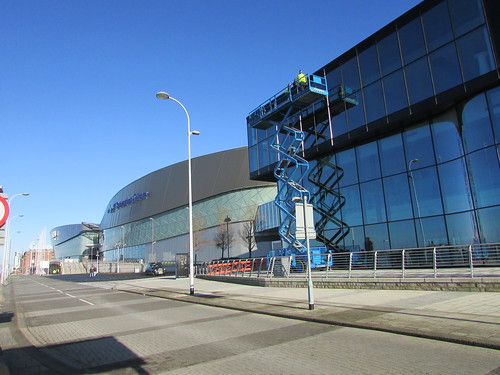
Kings Parade, Liverpool: (L-R) ECHO Arena, BT Convention Centre, Exhibition Centre Liverpool.
Related posts on other sites
Ship AIS (live map showing ships in Liverpool).
Related posts on this site
I've written about Liverpool many times. Most are referenced in the post Liverpool (again).
My Pictures
Where necessary, clicking on an image above will display an 'uncropped' view or, alternately, all the pictures from this and earlier trips may be selected, viewed or downloaded, in various sizes, from the albums listed:-
Liverpool South Docks
Liverpool area rail
Liverpool.
